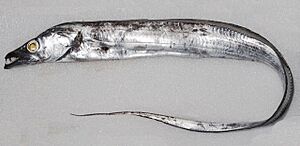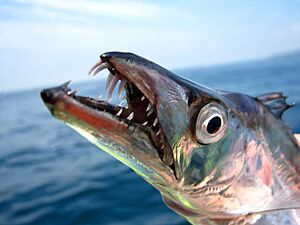Largehead hairtail facts for kids
Quick facts for kids Largehead hairtail |
|
|---|---|
 |
|
 |
|
| Conservation status | |
| Scientific classification | |
| Synonyms | |
|
The largehead hairtail (Trichiurus lepturus), also called the beltfish, is a type of cutlassfish. You can find this fish in warm and mild oceans all over the world. Scientists are still learning about its different types. For example, hairtails from the Atlantic Ocean are sometimes called Atlantic cutlassfish. Those from the East Pacific are called Pacific cutlassfish. And those from the Northwest Pacific are known as Japanese cutlassfish. This long, thin fish is a predator and is very important for fishing around the world.
Contents
What Does It Look Like?
Largehead hairtails are shiny, silvery-blue when alive. After they die, they turn a silvery-gray color. Their fins are usually see-through and might have a slight yellow tint. These fish have a very long, thin body that ends in a pointed tail. They do not have a regular fish tail. They have big eyes and a large mouth. Inside their mouth, you will see long, sharp, fang-like teeth.
Largehead hairtails can grow quite big. They can weigh up to 6 kilograms (13 pounds). They can also reach lengths of 2.34 meters (7 feet 8 inches). However, most are usually about 0.5 to 1 meter (1.6 to 3.3 feet) long. In Australia, it is common to see them grow to 1.5 to 1.8 meters (4.9 to 5.9 feet).
Where Do They Live?
Largehead hairtails live in tropical and temperate oceans worldwide. In the East Atlantic, they are found from the southern United Kingdom to South Africa. This includes the Mediterranean Sea. In the West Atlantic, they live from Virginia to northern Argentina. This area includes the Caribbean Sea and Gulf of Mexico. In the East Pacific, they range from southern California to Peru.
They are also common in the Indo-Pacific region. You can find them from the Red Sea to South Africa, Japan, and Australia. They are not found in the central Pacific Ocean, like near Hawaii. Some groups of these fish travel long distances.
Preferred Water Conditions
Largehead hairtails like certain water temperatures. A study in southern Japan showed they prefer water between 20 and 24 degrees Celsius (68–75 °F). In South Korea, they are mostly found in water warmer than 14 degrees Celsius (57 °F). Off southern Brazil, they prefer water warmer than 16 degrees Celsius (61 °F). They do not live in water colder than 10 degrees Celsius (50 °F).
These fish usually live in shallow coastal areas with muddy bottoms. Sometimes, they go into estuaries (where rivers meet the sea). They have been found at depths from 0 to 589 meters (0–1,932 feet). In Europe, they are often seen between 100 and 350 meters (330–1,150 feet) deep. They mostly live near the bottom of the ocean. But sometimes, they come up to the surface at night.
Life Cycle and Behavior
Young hairtails move up and down in the water each day. They rise at night to eat small fish and krill. During the day, they go back to the sea bed. Older hairtails do the opposite. They mainly eat other fish. They also eat squid and shrimp. Adult hairtails are very carnivorous. They sometimes even eat younger hairtails. These fish often swim together in large, crowded schools.
Reproduction
Spawning (laying eggs) depends on the water temperature. The baby fish (larvae) like water warmer than 21 degrees Celsius (70 °F). They are not found in water colder than 16 degrees Celsius (61 °F). So, in warm areas, they lay eggs all year. In colder places, they usually lay eggs in spring and summer. Each female lays thousands of eggs during a spawning season. These eggs float in the water and hatch in three to six days. In the Sea of Japan, most hairtails become adults when they are two years old. Some mature even earlier, at one year old. The oldest hairtail ever recorded lived for 15 years.
Fishing and How People Use It
The largehead hairtail is a very important fish for commercial fishing. In 2009, over 1.3 million tonnes of this fish were caught. This made it the sixth most important captured fish species. People catch this fish in many ways, like with large nets pulled along the bottom of the sea.
The biggest catches in 2009 were from China and Taiwan. Other countries that regularly catch hairtails include South Korea, Japan, Pakistan, Brazil, and Australia.
How It Is Eaten
In Korea, the largehead hairtail is called galchi. This name comes from a word meaning "sword fish." It is popular for frying or grilling. In Japan, it is called tachiuo, which also means "sword fish." There, people eat it grilled or raw, as sashimi. In Portugal and Brazil, it is called peixe-espada (sword-fish). They eat it grilled or fried.
When cooked, the largehead hairtail has firm but tender meat. It has a moderate fishy smell and is not very oily. It is also easy to remove the bones from this fish.
Images for kids









